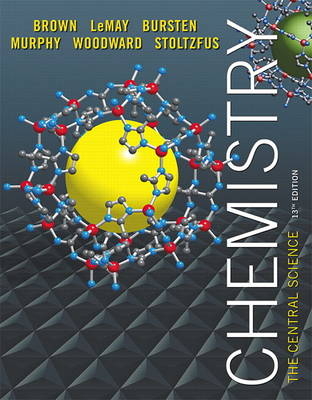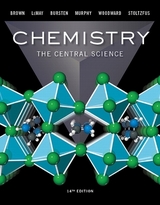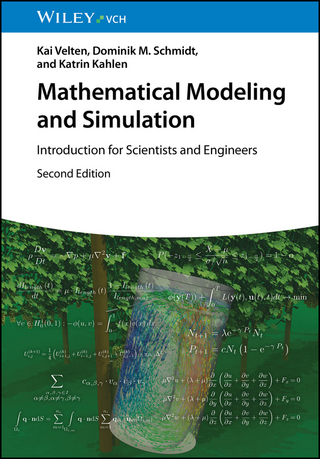
Chemistry
Pearson (Verlag)
978-0-321-91041-7 (ISBN)
- Titel erscheint in neuer Auflage
- Artikel merken
Unrivaled problems, notable scientific accuracy and currency, and remarkable clarity have made Chemistry: The Central Science the leading general chemistry text for more than a decade. Trusted, innovative, and calibrated, the text increases conceptual understanding and student success in general chemistry by building on the expertise of the dynamic author team of leading researchers and award-winning professors.
The new Thirteenth Edition builds on the Twelfth Edition’s major revision, in which every word and piece of art was scrutinized by all the authors to increase its effectiveness. Placing a greater emphasis on research, this edition is more tightly integrated with MasteringChemistry, the leading online homework, tutorial, and assessment program— resulting in an unparalleled teaching and learning package that personalizes learning and coaches students toward understanding and mastery of tough chemistry topics.
This program presents a better teaching and learning experience—for you and your students. It provides:
Superior support beyond the classroom with MasteringChemistry: Students benefit from personalized, interactive learning through MasteringChemistry’s self-paced tutorials that guide them through the text’s most challenging topics; provide immediate, specific feedback; and keep students engaged and on track.
Enhanced learning from a dynamic author team of leading researchers and award-winning professors: Each member of this well-respected author team brings their expertise in a wide range of areas to the pages of this popular text. All authors have been active researchers and have taught general chemistry for many years.
Improved conceptual understanding through stepped up, relevant pedagogy: Students get numerous opportunities to test their knowledge through Give It Some Thought (GIST) exercises, Go Figure questions, and A Closer Look essays, now integrated with clicker questions and in MasteringChemistry.
Invaluable aids that ensure problem-solving success: By using a consistent process, a unique Analyze/Plan/Solve/Check format, dual-column problem-solving approach in certain areas, a new practice exercise following each worked example, and the Strategies in Chemistry feature, students are placed on the right path from the very start to excel at problem solving and comprehension.
Clarity through visualization from a variety of perspectives, including macroscopic, microscopic, and symbolic: Included are Visualizing Concepts exercises, with models, graphs, and other visual materials; sample exercises with molecular illustrations; and conceptual questions in the end-of-chapter questions.
Note: You are purchasing a standalone product; MasteringChemistry does not come packaged with this content. If you would like to purchase both the physical text and MasteringChemistry search for ISBN-10: 0321864409/ISBN-13: 9780321864406. That package includes ISBN-10: 0321910419/ISBN-13: 9780321910417 and ISBN-10: 0321934245/ISBN-13: 9780321934246.
MasteringChemistry is not a self-paced technology and should only be purchased when required by an instructor.
THEODORE L. BROWN received his Ph.D. from Michigan State University in 1956. Since then, he has been a member of the faculty of the University of Illinois, Urbana-Champaign, where he is now Professor of Chemistry, Emeritus. He served as Vice Chancellor for Research, and Dean, The Graduate College, from 1980 to 1986, and as Founding Director of the Arnold and Mabel Beckman Institute for Advanced Science and Technology from 1987 to 1993. Professor Brown has been an Alfred P. Sloan Foundation Research Fellow and has been awarded a Guggenheim Fellowship. In 1972 he was awarded the American Chemical Society Award for Research in Inorganic Chemistry, and received the American Chemical Society Award for Distinguished Service in the Advancement of Inorganic Chemistry in 1993. He has been elected a Fellow of both the American Association for the Advancement of Science, the American Academy of Arts and Sciences, and the American Chemical Society. H. EUGENE LEMAY, JR., received his B.S. degree in Chemistry from Pacific Lutheran University (Washington) and his Ph.D. in Chemistry in 1966 from the University of Illinois (Urbana). He then joined the faculty of the University of Nevada, Reno, where he is currently Professor of Chemistry, Emeritus. He has enjoyed Visiting Professorships at the University of North Carolina at Chapel Hill, at the University College of Wales in Great Britain, and at the University of California, Los Angeles. Professor LeMay is a popular and effective teacher, who has taught thousands of students during more than 40 years of university teaching. Known for the clarity of his lectures and his sense of humor, he has received several teaching awards, including the University Distinguished Teacher of the Year Award (1991) and the first Regents’ Teaching Award given by the State of Nevada Board of Regents (1997). BRUCE E. BURSTEN received his Ph.D. in Chemistry from the University of Wisconsin in 1978. After two years as a National Science Foundation Postdoctoral Fellow at Texas A&M University, he joined the faculty of The Ohio State University, where he rose to the rank of Distinguished University Professor. In 2005, he moved to his present position at the University of Tennessee, Knoxville as Distinguished Professor of Chemistry and Dean of the College of Arts and Sciences. Professor Bursten has been a Camille and Henry Dreyfus Foundation Teacher-Scholar and an Alfred P. Sloan Foundation Research Fellow, and he is a Fellow of both the American Association for the Advancement of Science and the American Chemical Society. At Ohio State he has received the University Distinguished Teaching Award in 1982 and 1996, the Arts and Sciences Student Council Outstanding Teaching Award in 1984, and the University Distinguished Scholar Award in 1990. He received the Spiers Memorial Prize and Medal of the Royal Society of Chemistry in 2003, and the Morley Medal of the Cleveland Section of the American Chemical Society in 2005. He was President of the American Chemical Society for 2008. In addition to his teaching and service activities, Professor Bursten's research program focuses on compounds of the transition-metal and actinide elements. CATHERINE J. MURPHY received two B.S. degrees, one in Chemistry and one in Biochemistry, from the University of Illinois, Urbana-Champaign, in 1986. She received her Ph.D. in Chemistry from the University of Wisconsin in 1990. She was a National Science Foundation and National Institutes of Health Postdoctoral Fellow at the California Institute of Technology from 1990 to 1993. In 1993, she joined the faculty of the University of South Carolina, Columbia, becoming the Guy F. Lipscomb Professor of Chemistry in 2003. In 2009 she moved to the University of Illinois, Urbana-Champaign, as the Peter C. and Gretchen Miller Markunas Professor of Chemistry. Professor Murphy has been honored for both research and teaching as a Camille Dreyfus Teacher-Scholar, an Alfred P. Sloan Foundation Research Fellow, a Cottrell Scholar of the Research Corporation, a National Science Foundation CAREER Award winner, and a subsequent NSF Award for Special Creativity. She has also received a USC Mortar Board Excellence in Teaching Award, the USC Golden Key Faculty Award for Creative Integration of Research and Undergraduate Teaching, the USC Michael J. Mungo Undergraduate Teaching Award, and the USC Outstanding Undergraduate Research Mentor Award. Since 2006, Professor Murphy has served as a Senior Editor for the Journal of Physical Chemistry. In 2008 she was elected a Fellow of the American Association for the Advancement of Science. Professor Murphy’s research program focuses on the synthesis and optical properties of inorganic nanomaterials, and on the local structure and dynamics of the DNA double helix. PATRICK M. WOODWARD received B.S. degrees in both Chemistry and Engineering from Idaho State University in 1991. He received a M.S. degree in Materials Science and a Ph.D. in Chemistry from Oregon State University in 1996. He spent two years as a postdoctoral researcher in the Department of Physics at Brookhaven National Laboratory. In 1998, he joined the faculty of the Chemistry Department at The Ohio State University where he currently holds the rank of Professor. He has enjoyed visiting professorships at the University of Bordeaux, in France, and the University of Sydney, in Australia. Professor Woodward has been an Alfred P. Sloan Foundation Research Fellow and a National Science Foundation CAREER Award winner. He currently serves as an Associate Editor to the Journal of Solid State Chemistry and as the director of the Ohio REEL program, an NSF-funded center that works to bring authentic research experiments into the laboratories of first- and second-year chemistry classes in 15 colleges and universities across the state of Ohio. Professor Woodward’s research program focuses on understanding the links between bonding, structure and properties of solid state inorganic functional materials. MATTHEW W. STOLTZFUS received his B.S. degree in Chemistry from Millersville University in 2002 and his Ph. D. in Chemistry in 2007 from The Ohio State University. He spent two years as a teaching postdoctoral assistant for the Ohio REEL program, an NSF-funded center that works to bring authentic research experiments into the general chemistry lab curriculum in 15 colleges and universities across the state of Ohio. In 2009, he joined the faculty of Ohio State where he currently holds the position of Chemistry Lecturer. In addition to lecturing general chemistry, Stoltzfus accepted the Faculty Fellow position for the Digital First Initiative, inspiring instructors to offer engaging digital learning content to students through emerging technology. Through this initiative, he developed an iTunes U general chemistry course, which has attracted over 120,000 students from all over the world. Stoltzfus has received several teaching awards, including the inaugural Ohio State University 2013 Provost's Award for Distinguished Teaching by a Lecturer and he is recognized as an Apple Distinguished Educator.
1 Introduction: Matter and Measurement
2 Atoms, Molecules, and Ions
3 Chemical Reactions and Reaction Stoichiometry
4 Reactions in Aqueous Solution
5 Thermochemistry
6 Electronic Structure of Atoms
7 Periodic Properties of the Elements
8 Basic Concepts of Chemical Bonding
9 Molecular Geometry and Bonding Theories
10 Gases
11 Liquids and Intermolecular Forces
12 Solids and Modern Materials
13 Properties of Solutions
14 Chemical Kinetics
15 Chemical Equilibrium
16 Acid—Base Equilibria
17 Additional Aspects of Aqueous Equilibria
18 Chemistry of the Environment
19 Chemical Thermodynamics
20 Electrochemistry
21 Nuclear Chemistry
22 Chemistry of the Nonmetals
23 Transition Metals and Coordination Chemistry
24 The Chemistry of Life: Organic and Biological Chemistry
Appendices
A Mathematical Operations
B Properties of Water
C Thermodynamic Quantities for Selected Substances at 298.15 K (25 °C)
D Aqueous Equilibrium Constants
E Standard Reduction Potentials at 25 °C
Answers to Selected Exercises
Answers to “Give It Some Thought”
Answers to “Go Figure”
Answers to Selected Practice Exercises
| Erscheint lt. Verlag | 13.2.2014 |
|---|---|
| Sprache | englisch |
| Maße | 216 x 276 mm |
| Themenwelt | Naturwissenschaften ► Chemie |
| ISBN-10 | 0-321-91041-9 / 0321910419 |
| ISBN-13 | 978-0-321-91041-7 / 9780321910417 |
| Zustand | Neuware |
| Informationen gemäß Produktsicherheitsverordnung (GPSR) | |
| Haben Sie eine Frage zum Produkt? |
aus dem Bereich



